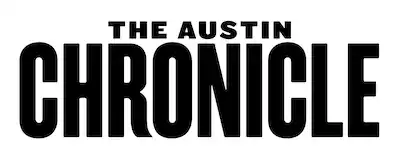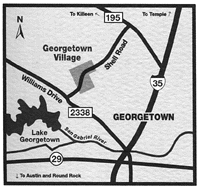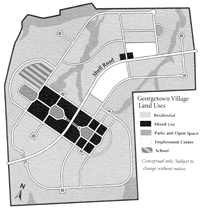https://www.austinchronicle.com/news/1998-07-31/523693/
A Budding Hamlet
Georgetown Village: Smart Growth Without Trying
By Mike Clark-Madison, July 31, 1998, News
|
|
A while back, when the city of Austin passed its Traditional Neighborhood District (TND) zoning ordinance, we commemorated the occasion in "Corner to Corner" with a mock ad (tired journalist's trick though it was) for "Public Realm Village," the worthy and righteous mixed-use, high-density, character-filled and transit-oriented subdivision of local New Urbanist dreams. We thought we were kidding. But here we are, on Georgetown's newly annexed western fringe, not quite as far out as Sun City but close thereto, surveying the embryonic form of Georgetown Village, the Austin metro area's first bona fide (or at least close-enough-for-jazz) neo-traditional development. Repeat: In Georgetown, seat of Williamson County, not a place known for turning progressive land-use ideas into sticks-in-the-air. And being built out, at least in its residential sectors, by - this is where it gets really weird - David Weekley Homes, one of Austin's (and Texas', and America's) largest homebuilders.
You see, when back in the 1980s the pioneer NewUrbs envisioned TNDs and their kin, they posited them as an alternative to the reigning mode of development and land use - i.e., spraaaaaaawl - being wreaked by big developers in the suburbs of America. To see one of those developers embrace the TND concept and, in our metro area, take the risk of marketing it, is very heartening, but also threatening to some NewUrb premises.
For "sprawl" is a fighting word, and many progressives have copped quite a bit of attitude about the likes of David Weekley, and at least a little of that attitude shadowed the creation of Austin's own TND ordinance. That is, Austin was more enlightened than Williamson County, and we needed to make it easier (through the creation of a custom zoning code) to build leading-edge developments here, because outlying jurisdictions wouldn't allow them, and we needed to make it easier for smaller, more risk-ready developers, because big boys like Weekley wouldn't touch TNDs with gloves on.
So Georgetown Village is, to say the least, a pleasant surprise, though it may be a bit of an embarrassment in some Austin political quarters. Let's knock on the gate.
A Burg in Progress
Right now, Georgetown Village looks like most subdivisions in their larval stage, a mélange of newly paved roads, pink survey flags, sweaty work crews, and pristine model homes. But even this evidence is enough to indicate that something different is happening here.
Take those roads, for instance: None of them dead-end. A unique feature of the Village is its "court lanes," short and quite narrow U-shaped streets that serve the function of cul-de-sacs in conventional subdivisions. The space in the middle of the U, between the court lanes (which only have lots on one side) and their connecting streets, is to become usable green space, i.e., "pocket parks."
|
|
Georgetown Village also boasts alleys, which haven't been included in single-family residential developments around here for decades. These service lanes allow for access to the hidden, in some cases detached, garages featured on many of Weekley's house plans. "In most developments, the first thing you see from the street is the garage," says Wendy Waugh of the city of Georgetown's planning department, manager of the Village's planned-unit development (PUD) zoning case. "They're the primary focal points. [Georgetown Village] is really an experiment."
The court lanes, in particular, make the city of Georgetown, and especially its fire department, a little nervous. "Our city departments" - including fire, public works, and the local utilities - "were very much a part of the discussions" that led to the approval of the Village PUD, Walsh says. "So what's going on is what they agreed to, but [the city] will be evaluating the court lanes, especially, to see what happens in a year or two."
These things matter, in part, because of the Village's density - the first court lane one encounters entering from Shell Road, dubbed Fairfield Court, is about as wide across as many suburban cul-de-sacs, but has 11 lots on it. The standard lot size in Georgetown Village is 55'x125', comparable to lots in the oldest Central Austin single-family neighborhoods, and about half the size of the typical suburban lot.
There will be larger lots (with 70-foot frontage) elsewhere in the Village for "estate homes," and even a 55-foot lot is far from true urban density, but all things are relative. "Usually, in Georgetown, we get very low densities," says Walsh, pointing to subdivisions, comparable in raw land area, with as few as 50-100 homes, while this project will likely have five to 10 times as many. "They're doing a lot more homes than that, and incorporating a mix of different densities - and uses. That's where I see the biggest difference."
Of course, it wouldn't be NewUrb and NeoTrad without mixed uses, and Georgetown Village incorporates the urban-design concepts that, on paper and in focus group meetings, have become clichés even though they scarcely exist on the ground. Land (about 20 acres) is set aside for an "employment center," and the true-mixed-use (i.e., residential and commercial in the same building) "town center" is artfully arranged around the "commons." There will be a variety of multi-family, townhouse, zero-lot-line, etc. properties, along with - perhaps even alongside - the single-family homes. The common areas will be maintained not by a mandatory homeowners' association, but by a self-taxing public improvement district - the same legal vehicle used by the Downtown Austin Alliance.
What will actually end up in those mixed areas is an open question, since none of the non-residential sectors of the Village (except the new Village Elementary School) have proceeded past the concept stage. The market for commercial property in Georgetown Village has already been shaped by the land rush nearby along Williams Drive, aka the Road-to-Sun-City, where dozens of parcels are either on the market or under development. A new HEB shopping center - i.e., big-box strip-center retail, totally un-NewUrb - is already on tap for the corner of Williams and Shell Road, next to the Village.
Which calls up the unanswered question about TNDs in general, to wit: Neo-traditional "people-oriented" neighborhoods with small lots, front porches, and gabled roofs may be attractive to homebuyers burned out on the ranch-house tract. But can they compete in a commercial real-estate market that's attuned to the entirely opposite values of big-box centers and office campuses? Without those commercial uses, TNDs ain't mixed-use, and their residents have to drive to work and shop elsewhere, and ... well, you get the point.
To head off this scenario, many TNDs around the country have gone the luxury route, cherry-picking affluent homebuyers with disposable income who are jazzed by the projects' heavy investments in greenspace and infrastructure, by their artful (some would say theme-park) architectural standards and controls, or simply by the buzz value of New Urbanism. This is true of resort communities like Florida's Seaside, the granddaddy of all TNDs; of high-end suburbs like Maryland's Kentlands and Sacramento's Laguna West; and of corporate-sponsored "new towns" like Disney's Celebration, where David Weekley is also building homes. It does not appear, though, to be true of Georgetown Village.
Acknowledging the real world of Texas real estate, where size is damn near everything, the Village is the least expensive of Weekley's current Austin-area projects, with the smallest home starting at $130,000. That's still above the Metro Austin median home price, but it's not bad for desirable west-of-I-35 new Williamson County suburbs. That "smallest" home is still nearly 1,500 square feet; the largest plan offered on the 55-foot lots is over 2,600 square feet. (This does eliminate wasteful expanses of lawn, but many of our new, steroidal subdivisions have already accomplished that.)
|
|
But again, all things are relative, and the Georgetown Village vision is unique enough for this area to throw customers off. "It's been really difficult for people to visualize," says George Eggert, the development's sales manager. "I've been showing them pictures of Celebration and of downtown Georgetown, and they seem to respond well to those. But there's definitely a lot of excitement."
Many of the people who've looked at the Village, Eggert says, are "empty-nesters; [it has] appeal for people who came to visit Sun City but who decided they didn't want that." But the primary market, he adds, "is definitely young families. The new school" - which will be the only campus in the Georgetown ISD serving all the elementary grades - "is a big draw. It adds to the excitement."
With the explosive growth of the region, every community wants, or says it wants, to create quality housing options for those young families, the first-time homebuyers and new-to-the-areas, without the destructive side effects of sprawl. It's certainly a much-voiced goal in Austin, and that brings us back to land-use policies.
For what it's worth, Georgetown has no TND ordinance, or even adopted urban design guidelines for the city as a whole. (Such guidelines - which Austin ostensibly adopted back in the 1970s as part of Austin Tomorrow - are on their way to the Georgetown City Council.) According to Walsh, Georgetown Village was going to be the test tube through which the city created traditional neighborhood guidelines, but the planned development agreement that codified the TND rules never materialized. "Right now," she says, "they're working simply on their own initiative."
In other words, the Village is making up its own TND rules as it goes along. The plats recorded for the Village at the Williamson County Courthouse are simply lot lines, whereas, Walsh says, developers in other Georgetown projects have committed to elevations, facades, floor plans, and the location of garages in the plats themselves. Rest assured that TND projects in Austin - whether developed under the TND ordinance or as PUDs - have to commit in writing and in great detail to the NewUrb specifics that, at Georgetown Village, have basically been agreed to over a handshake. Rather than go to great lengths to define what NeoTrad development is and how it can be achieved, Georgetown has simply gotten out of the way.
What does all this mean? Well, it may mean that the city of Georgetown is being taken for a ride, and that the Village will end up being less than a NewUrb ideal, but so what? Again, all things are relative. Until a privately funded TND, built under Austin's ordinance, breaks ground in Austin's desired development zone, Williamson County may be able to crow that they, and not we, have brought real "smart growth" to Central Texas.
Copyright © 2025 Austin Chronicle Corporation. All rights reserved.



